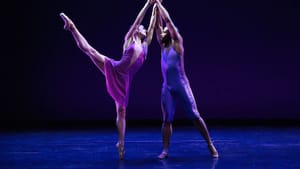Stay in the Loop
BSR publishes on a weekly schedule, with an email newsletter every Wednesday and Thursday morning. There’s no paywall, and subscribing is always free.
Hot dance in a winter storm
BalletX presents 'Spring Series' 2018 with Matthew Neenan, Darrell Grand Moultrie, and Trey McIntyre

The March nor’easter that brought thundersnow, slush puddles, and citywide closures could not stop opening night for BalletX’s Spring Series. The program includes “Increasing,” a 2014 work by resident choreographer and cofounder Matthew Neenan, and two world premieres: Darrell Grand Moultrie’s “Vivir” and Trey McIntyre’s “The Boogeyman.”
The Spring Series features a special synthesis between sound and movement, one that dancers and audience members can see and feel. Music ranges from Latin jazz and classical to R&B and funk, offering something for every ear as well as a diversity reflecting the choreographers’ skills. Most important, the Spring Series allows dancers to explore different tempos and moods, tell stories, and show off their considerable talents.
Nostalgic dance through life
The performance opened with “Vivir,” celebrating the sounds and emotions of Moultrie’s childhood home in Spanish Harlem. Featuring songs by Tito Puente, Rodrigo y Gabriela, and Bebo & Cigala, the dance captured both the joy and pain of its soundtrack. The pain emerged in a solo during which Gary W. Jeter II kept one hand close to his body. Suggesting heartache, the hand remained still on his face, head, chest, and torso while the rest of his body moved.
At the end, Jeter lay prone upon the floor but still moving, his body circling like a clock with limbs resembling minute and second hands. I thought of the bittersweet love people can feel for their former homes: nostalgia for places and people which sometimes no longer exist. However, “Vivir” mostly emphasized the determined exuberance of its title, meaning “to live.”
Dancers entered and exited frequently, alone and in combination, like people moving through their neighborhood and throwing the occasional block party. Shoulder rolls and shimmies evoked impromptu dancing and footwork incorporated salsalike steps. Soaring jumps and twitching hands and feet signaled uncontained energy. Mark Eric’s attractive, colorful costumes fit the different moods of the music and movement. Flesh-colored panels made it hard to tell where fabric ended and skin began, mirroring the way sound and dance overlapped.
Live music and movement
Next came “Increasing,” a dance set to Schubert’s String Quintet in C Major. Violinists Piotr Filochowski and Eunice Kim, cellists Glenn Fischbach and Branson Yeast, and violist Yoshihiko Nakano accompanied. The musicians shared the stage with the dancers, an artistic choice possibly dictated by space constraints at the Wilma Theater, but one that reinforced the symbiosis.
The musicians’ presence sometimes distracted, but dancers’ movements captured the tone of what they played. Physical flourishes with arms and shoulders matched elements of the music, and formations and lines of dancers came together and broke apart with the same pleasant chaos as the score.

A highlight included duets simultaneously performed by Caili Quan and Skyler Lubin and two male dancers. At one point, the partnering shifted and the men danced with the women. In another duet, Zachary Kapeluck and guest dancer Jenny Winton showed palpable chemistry, maintaining eye contact throughout. When Kapeluck stepped away, his arm movements seemed to call Winton back and she quickly returned to him.
Boogey-down production
The program concluded with “The Boogeyman,” a rousing dance set to the sounds of 1970s artists such as Stevie Wonder and Earth, Wind, and Fire. McIntyre dedicated the work to the Soul Train dancers he credits with saving him. I found the piece most effective in conveying how music compels movement and how moving to music can help us process emotion.
“The Boogeyman” tells a loose story of two young people, danced by Roderick Phifer and Andrea Yorita, coming to terms with their developing identities and impending adulthood through dancing to popular music. Marvin Gaye’s “Got to Give it Up” played before the lights came up to reveal Phifer in what looked like a childhood bedroom, complete with a bed, listening to music on headphones connected to a pre-digital-era console.
After making sure no one was watching, Phifer began to dance. The wire connecting his headphones to the record player symbolized a lifeline for expressing feelings difficult for anyone, especially adolescents, to put in words: longing, fear, isolation, hope, and loss. Later, Yorita danced on and around the bed. When Phifer joined her, they performed the same movements without quite dancing together.
My favorite sections of “The Boogeyman” brought in Jeter, Kapeluck, Lubin, Daniel Mayo, and Francesca Forcella as de facto Soul Train dancers who executed energetic disco-inspired turns and hand claps in Andrea Lauer’s deliciously retro costumes (think velour bellbottoms).
“You will be hard pressed to resist dancing along with us in the seats,” Kapeluck warns in the Spring Series program notes, and he is right. It was well worth braving the elements for this BalletX performance, and dance lovers should not miss it.
What, When, Where
Spring Series. "Vivir," by Darrell Grand Moultrie; "Increasing," by Matthew Neenan; "The Boogeyman," by Trey McIntyre. BalletX. March 7-18, 2018, at the Wilma Theater, 265 S Broad Street, Philadelphia. (215) 545-7824 or balletx.org.
Sign up for our newsletter
All of the week's new articles, all in one place. Sign up for the free weekly BSR newsletters, and don't miss a conversation.
 Melissa Strong
Melissa Strong